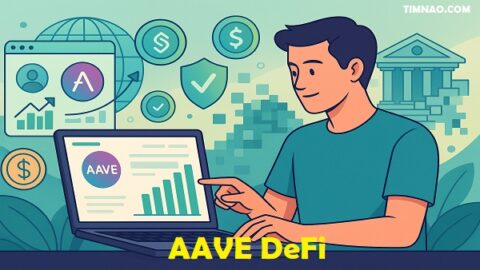Essential Blockchain Application Security: The Ultimate Beginner’s Blueprint 🚀
If you’re curious about blockchain application security but feel overwhelmed by jargon, you’re absolutely not alone.
In just a few years, blockchains have gone from niche tech to the backbone of DeFi, NFTs, gaming, and digital identity.
That also means attackers are paying attention: billions of dollars have been stolen from vulnerable smart contracts and poorly secured dApps.
The good news is that you don’t need to be a cryptography wizard to start building safer systems.
With a solid understanding of blockchain application security, secure dApp development becomes much more approachable.
This guide will walk you through the key concepts, common mistakes, and practical steps you can take as a beginner to protect users, funds, and your reputation.
🔐 What Is Blockchain Application Security?
When people first hear “blockchain application security,” they often think it’s something only hardcore cryptographers or security engineers need to care about.
But if you’re building, testing, or even just using dApps, wallets, or smart contracts, blockchain application security is already part of your world—even if you’ve never called it by name.
At its core, blockchain application security is about protecting everything that sits on top of a blockchain network:
- Smart contracts (the on-chain code)
- Decentralized applications (dApps) and their web/mobile front-ends
- Wallets and keys that sign transactions
- Off-chain services (APIs, backends, oracles) that interact with the chain
Traditional cybersecurity focuses on servers, databases, and corporate networks.
With blockchain, you still care about all of that, but you’re also dealing with immutable code that directly controls money and critical state.
If a smart contract has a bug or a dApp leaks a private key, the consequences are usually immediate and irreversible—there’s no “undo” button, no support ticket to roll back a bad transaction.
Industry reports show that billions of dollars in crypto are lost every year to hacks, scams, and security failures, ranging from protocol-level exploits to simple wallet compromises.
For beginners, these big numbers can feel abstract, but the message is simple:
if value flows through your app, security is not an optional extra—it’s part of the product.
Security Is a Process, Not a Single Feature
A common misconception is that blockchain security is “just” about choosing a secure chain or using strong cryptography.
In reality, it’s more like a continuous process of risk management, very similar to what big companies already do with traditional cybersecurity.
That process usually includes:
- Identifying what can go wrong
What assets are at risk (funds, NFTs, governance rights, private data)? - Understanding threats
Who might attack you: random hackers, insiders, bots, or even your own users by mistake? - Implementing controls
Things like access control, secure coding practices, audits, monitoring, and safe user flows. - Continuously improving
Applying lessons from audits, incidents, bug reports, and updates to security standards like the OWASP Blockchain AppSec Standard.
If you’re just starting out, you don’t need to master all of this at once.
But it helps to think of blockchain application security as:
“how we design, build, and operate dApps so that users don’t lose money, data, or control.”
How Blockchain Application Security Relates to Secure dApp Development
Secure dApp development is essentially the hands-on part of blockchain application security.
It’s the day-to-day decisions you make when you:
- Pick a framework like Hardhat or Foundry
- Choose security-hardened libraries such as OpenZeppelin Contracts
- Design how users connect wallets via MetaMask or WalletConnect
- Decide which operations require multisig or timelocks instead of a single admin key
A useful mindset for beginners is:
“Every design choice I make either reduces risk, keeps risk the same, or increases risk. My job is to push things toward lower risk without killing usability.”
You don’t need a perfect system.
You just need to avoid the most common, well-known mistakes that keep causing the same types of hacks again and again.
This is exactly what standards from OWASP for blockchain and smart contracts are trying to help with.
🧱 How Blockchains Actually Work (Without the Buzzwords)
To build or secure anything on blockchain, you need a mental model of what’s happening under the hood—but not a PhD-level one.
Let’s walk through the basics in plain language, focusing on what actually matters for security and secure dApp development.
At a high level, a blockchain is a shared digital ledger.
Instead of one company owning a database, many different computers (nodes) maintain a synchronized record of:
- Who owns what
- Which transactions happened
- What state each smart contract is in
These nodes bundle transactions into blocks.
Each block is linked cryptographically to the previous one, forming a chain that’s very hard to tamper with without being noticed.
This is why blockchains are often called “append-only”—you can add new data, but rewriting history is extremely difficult.
From a security perspective, this gives you:
- Integrity: it’s very hard to secretly change old data.
- Transparency: transactions and contract code are visible on block explorers like Etherscan.
- Shared state: everyone agrees on the current balances and contract states.
But remember: the blockchain itself doesn’t understand what is “fair” or “safe.”
It just executes whatever code and transactions it’s given.
If the code is flawed, the ledger will faithfully record the exploit too.
Public vs Private Chains: Who Are You Defending Against?
Not all blockchains are the same.
The way security works depends a lot on the type of network:
- Public blockchains (e.g. Ethereum, Bitcoin)
- Anyone can join, send transactions, and deploy contracts.
- You must assume anyone could be an attacker.
- Great for open DeFi, NFTs, and public dApps.
- Permissioned / private blockchains (e.g. some Hyperledger Fabric deployments)
- Only approved organizations run nodes or submit certain transactions.
- Threats are more about insiders, misconfigurations, and governance disputes.
- Common in enterprise, supply chain, and B2B scenarios.
For beginners, this matters because:
- On public chains, your contracts and dApps are exposed to global, 24/7 attack traffic.
- On private chains, you may rely more on organizational security (access control, network segmentation, audits).
Both still need secure coding and careful key management.
But you’ll prioritize different controls depending on how open your network is.
Smart Contracts: Programs That Hold Real Money
Smart contracts are where blockchain application security becomes very concrete.
Instead of your logic running on a server you control, it runs inside the blockchain’s virtual machine and is triggered by transactions.
Key characteristics to understand:
- Deterministic
Every node must reach the same result when running your contract. - Immutable (mostly)
Once deployed, smart contracts are difficult or impossible to change. - Direct control of assets
Contracts often hold tokens, manage collateral, or decide who can withdraw.
From a beginner’s perspective, a smart contract is a bank vault whose behavior is defined entirely by code.
If the code says “anyone can withdraw,” the blockchain will happily allow that.
This is why secure dApp development spends so much time on smart contract security—it’s not just software quality, it’s financial safety.
Off-Chain Components Still Matter
It’s easy to obsess about smart contracts and forget everything else.
But most real systems also include:
- A web app or mobile app (the dApp front-end)
- APIs or backends that index blockchain data
- Oracles that feed in off-chain information (like prices)
- DevOps infrastructure: CI/CD pipelines, cloud environments, logging and monitoring
Classic web vulnerabilities like those in the OWASP Top 10—XSS, SQL injection, broken access control—still apply here.
If your front-end is compromised, an attacker can trick users into signing malicious transactions even if your smart contracts are perfectly written.
So, when you think “blockchain application security,” picture the whole system:
- On-chain logic
- Off-chain services
- Wallets and keys
- Users and their devices
This holistic view is what separates secure dApp development from “just writing Solidity that compiles.”
😬 The Biggest Risks Beginners Overlook
Many beginners assume blockchain is magically secure because it uses cryptography and consensus.
In reality, most real-world incidents don’t come from the blockchain protocol itself—they come from application-level mistakes, poor key management, and basic web security gaps.
Let’s go through some of the most common pitfalls and what you can do about them, even as a beginner.
1. Believing “It’s On-Chain, So It Must Be Safe”
Just because a contract is verified on a block explorer doesn’t mean it’s trustworthy.
Attackers can deploy smart contracts that look legitimate but contain hidden backdoors, unfair fees, or rug-pull logic.
What you can do instead:
- Favor audited projects
- Avoid interacting with random contract addresses
- Publish transparent documentation if you’re the builder
2. Ignoring Basic Web and API Security
A large number of Web3 hacks still boil down to classic web vulnerabilities like XSS or insecure APIs.
If your front-end is compromised, attackers can:
- Replace contract addresses
- Trick users into signing malicious transactions
- Inject scripts that steal session data
Beginner-friendly defenses:
- Use CSP headers
- Avoid loading untrusted third-party scripts
- Treat your dApp like a modern web app with established security best practices
3. Underestimating Key and Wallet Security
A huge portion of losses come from mismanaged private keys.
Common mistakes:
- Storing seed phrases in screenshots or cloud notes
- Using one wallet for everything
- Deploying contracts using a hot wallet on a laptop
Simple fixes:
- Use hardware wallets
- Separate personal wallets from admin wallets
- Prefer multisig solutions like Safe (Gnosis Safe)
4. Not Thinking About Access Control
Access control misunderstandings cause catastrophic failures.
Typical issues:
- Admin-only functions left public
- No timelock on powerful operations
- A single EOA holding god-mode privileges
Always decide who can call what before you start coding.
5. Soft Attacks: Phishing and Social Engineering
Fake websites, fake apps, and fake support accounts are everywhere.
What your dApp can do:
- Provide clear transaction descriptions
- Publish your official links prominently
- Warn users to never share seed phrases
6. Skipping Testing and Relying Only on “It Compiles”
Testing is non-negotiable.
You should include:
- Unit tests
- Integration tests
- Fuzz testing
- Static analysis
- Human review
Even small projects benefit massively from basic test coverage.
🛠️ Designing a Secure dApp Step by Step
Most beginners struggle with blockchain security because much of the advice online feels like abstract theory.
So let’s change gears.
This section is written as a realistic, step-by-step playbook for creating a secure dApp — even if you’re not a professional security engineer.
Each step includes:
- What to do
- Why it matters
- How to actually do it (tools, commands, examples)
Whether you’re building a DeFi pool, NFT minting site, or a simple token contract, these steps apply to nearly all dApps.
Step 1 — Start With Clear User Flows Before Touching Code
Most security issues happen because people start coding before they understand what their app must do.
Your task:
Create 3–5 simple “user flows.”
These are everyday actions your users will perform.
Examples:
- “A user connects their wallet and deposits tokens.”
- “A user mints an NFT.”
- “An admin upgrades the contract.”
- “A user claims staking rewards.”
Why this matters:
Security is easier when you have a map of what people do.
Every security check you write later will be based on this map.
Beginner Tip:
Write each user flow in one short sentence. Keep it simple.
Step 2 — Identify Risks for Each Flow (Threat Modeling Made Simple)
Threat modeling sounds like something scary only corporations do, but you can do a lightweight version in minutes.
For each user flow, ask three questions:
- What valuable thing is happening?
(e.g., tokens move, NFTs are minted, admin changes config) - What could go wrong?
(e.g., attacker drains funds, someone calls this function at the wrong time) - What simple rule would prevent that?
(e.g., verify caller, limit max withdrawal, check timestamps)
Example (very beginner-friendly):
| User flow | What could go wrong? | Prevention |
|---|---|---|
| Deposit tokens | Someone deposits for another user | Require msg.sender == user |
| Withdraw tokens | Attacker drains the pool | Check balance before transferring |
| Upgrade contract | Malicious admin updates logic | Use multisig + timelock |
This quick exercise becomes your security blueprint.
Step 3 — Set Up a Secure Development Environment
Now we get practical.
You need tools that developers and auditors actually use.
Install Node.js
Download from: https://nodejs.org
Install Hardhat (recommended for beginners):
mkdir my-secure-dapp
cd my-secure-dapp
npm init -y
npm install --save-dev hardhat
npx hardhat
Choose “Create a JavaScript project”.
Why Hardhat?
- Easy to use
- Works with all major security tools
- Supports testing, deployment, and linting
If you prefer Foundry, you can use that too, but Hardhat is friendlier at first.
Step 4 — Use Secure, Audited Smart Contract Templates
Here’s the part many beginners do wrong:
They start coding Solidity from scratch or copy random snippets from Medium.
Instead, use OpenZeppelin Contracts, which are audited and industry-standard.
npm install @openzeppelin/contracts
Example: create a secure ERC-20 token:
// contracts/MyToken.sol
// SPDX-License-Identifier: MIT
pragma solidity ^0.8.20;
import "@openzeppelin/contracts/token/ERC20/ERC20.sol";
import "@openzeppelin/contracts/access/Ownable.sol";
contract MyToken is ERC20, Ownable {
constructor() ERC20("MyToken", "MTK") {
_mint(msg.sender, 1_000_000 ether);
}
}
This contract is secure out-of-the-box because it uses professionally audited code.
Why beginners love this:
You don’t need to understand every detail of ERC-20.
You just extend a trusted library.
Step 5 — Add Basic Security Controls (The 4 Things Every dApp Needs)
Almost all secure dApps include these four patterns:
1. Access Control
Decide who can call admin-level functions.
Use:
import "@openzeppelin/contracts/access/Ownable.sol";
Then:
function setFee(uint256 newFee) external onlyOwner {
fee = newFee;
}
2. Checks-Effects-Interactions Pattern
Always update internal state before sending tokens.
Bad:
token.transfer(msg.sender, amount);
balances[msg.sender] -= amount;
Good:
balances[msg.sender] -= amount;
token.transfer(msg.sender, amount);
3. Reentrancy Guard
Add this to prevent draining attacks:
import "@openzeppelin/contracts/security/ReentrancyGuard.sol";
contract Pool is ReentrancyGuard { }
Use:
function withdraw() external nonReentrant { ... }
4. Emergency Stop (Pause Function)
For responding to incidents fast:
import "@openzeppelin/contracts/security/Pausable.sol";
Then:
function deposit(uint256 amount) external whenNotPaused { ... }
function pause() external onlyOwner { _pause(); }
This simple pattern has saved many projects from disaster.
Step 6 — Test Your Smart Contracts Thoroughly
Testing is the easiest way to avoid hacks.
In Hardhat, create a file:
test/mytoken.js
Example test:
const { expect } = require("chai");
describe("MyToken", function () {
it("mints tokens to deployer", async function () {
const [owner] = await ethers.getSigners();
const Token = await ethers.getContractFactory("MyToken");
const token = await Token.deploy();
expect(await token.balanceOf(owner.address)).to.equal(ethers.parseEther("1000000"));
});
});
Run it:
npx hardhat test
If your dApp handles money, tests are not optional.
Step 7 — Run Security Tools That Professionals Use
These tools scan your contracts for bugs automatically:
Install Slither (very important)
pip3 install slither-analyzer
slither .
Slither detects common vulnerabilities like reentrancy, access control issues, and unsafe calls.
Install Solhint (linter)
npm install --save-dev solhint
npx solhint "contracts/**/*.sol"
These tools instantly improve your code quality.
Step 8 — Deploy Securely (Never Deploy From Your Hot Wallet)
Beginners often deploy contracts from MetaMask on their laptop.
That’s dangerous.
Better options:
- Use a hardware wallet (Ledger, Trezor).
- Use a multisig wallet if the contract is important.
- Use Hardhat scripts instead of manual deployment.
Example:
// scripts/deploy.js
async function main() {
const Token = await ethers.getContractFactory("MyToken");
const token = await Token.deploy();
await token.waitForDeployment();
console.log("Token deployed to:", await token.getAddress());
}
main();
Run:
npx hardhat run scripts/deploy.js --network sepolia
This ensures repeatable, transparent deployments.
Step 9 — Build a Safe Front-End
Even if your contracts are secure, your UI might expose users to scams.
Here’s how to build a safer UI:
1. Only load scripts from trusted sources.
Avoid random CDN scripts.
2. Sanitize user input.
If your UI takes text input (NFT names, metadata, notes), sanitize them to avoid XSS.
3. Show clear transaction descriptions.
Help users understand exactly what they’re signing.
4. Warn users when interacting with risky functions.
Especially infinite approvals or admin-level features.
5. Use wallet libraries like
These libraries simplify security best practices.
🧩 Smart Contract Security for Non-Gurus
Now that you’ve seen how to build a secure dApp structure, let’s focus on smart contract security — but without overwhelming theory.
Below are the highest-impact, easiest-to-learn security techniques anyone can apply.
1. Use Existing Libraries Instead of Writing Your Own Logic
A rule of thumb:
“If OpenZeppelin already has it, do NOT write your own version.”
Examples of functionality you should NEVER reinvent:
- ERC-20 and ERC-721 tokens
- Access control
- Pausable / ReentrancyGuard
- Timelocks
- Upgradeable proxies
Using audited code eliminates 80% of beginner-level vulnerabilities immediately.
2. Avoid the 5 Most Common Vulnerabilities (Made Simple)
Here’s what beginners run into most:
Reentrancy
Always update your internal state before sending tokens.
Unchecked External Calls
Never assume an external contract behaves.
Use:
require(success, "Call failed");
Authorization Mistakes
Use modifiers like onlyOwner or role-based access control.
Math Overflows (less common now)
Solidity 0.8+ includes built-in overflow checks, but you still need to test edge cases.
Oracle Manipulation
Use trusted oracle networks like Chainlink instead of pulling prices from a single DEX.
3. Write Tests That Focus on Failure, Not Success
Examples of tests beginners should always write:
- Calling a restricted function from an unauthorized address
- Passing weird numbers (0, max uint)
- Trying to withdraw more than deposited
- Simulating malicious contracts calling your functions
Failure tests reveal more than success tests.
4. Use Tools Like a Professional Auditor (Even If You’re Not One)
Even beginners can run these:
- Slither → static analysis
- Mythril → symbolic analysis
- Foundry fuzzing → random input testing
- Hardhat coverage → ensures your tests touch important code paths
Use all tools at least once before deployment.
🔑 Protecting Wallets, Keys, and Users
Smart contract bugs are dangerous, but lost private keys are worse.
This section gives you practical wallet security steps for both builders and everyday users.
1. Separate Your Wallets Into 3 Tiers
Use this exact setup:
Tier 1 — Daily Hot Wallet
For: testing, interacting with dApps
Tools: MetaMask, Rabby
Tier 2 — Hardware Wallet
For: personal funds, deploying contracts
Tools: Ledger, Trezor
Tier 3 — Multisig Wallet
For: protocol treasury, admin control
Tools: Safe Global
This single practice prevents beginner-level disasters.
2. Never Store Seed Phrases Digitally
Do NOT store seed phrases in:
- Screenshots
- Google Drive
- Notion
- Phone gallery
- Discord
- Telegram
Better alternatives:
- Write it on paper and store securely
- Use a metal backup plate
- Use hardware wallet recovery solutions
3. Teach Your Users Through Your UI
A secure dApp educates users inside the product.
Ideas:
- Show “Never share your seed phrase” reminders
- Ask users to verify the contract address
- Provide a link to your official docs
- Warn before unlimited token approvals
- Disable actions if wallet is on an unsafe network
Even one clear warning prevents countless phishing incidents.
4. Protect Your Team With Simple Operational Security
If you work on a project:
- Require multisig approval for all major actions
- Store hardware wallets in different physical locations
- Rotate access when team members leave
- Avoid sharing private keys through chat apps
- Revoke permissions people no longer need
These steps are simple but extremely effective.
🕵️♀️ Privacy, Identity, and Compliance in Web3
When people first hear “Web3,” they usually think of transparency: everything is public, every transaction is visible, and the code is open.
That’s true at the blockchain level, but it doesn’t mean privacy and identity suddenly stop mattering.
If anything, they matter more, because public blockchains are like permanent public logs: once something sensitive goes on-chain, it’s very hard to take it back.
As a beginner, you don’t need to become a privacy expert or a lawyer.
But you do need a basic mental model:
- What data should never go on-chain
- How to handle identity in a safer way
- What “compliance” roughly means, so you don’t walk into trouble by accident
Let’s break this down into practical, do-able steps you can apply right away in your dApp.
What You Should Never Put On-Chain
A good starting rule is simple:
If revealing a piece of information publicly forever would be bad for a user, don’t put it on a public blockchain.
Things that should not go on-chain include:
- Real names, emails, phone numbers
- Exact home addresses
- Government ID numbers (passport, national ID, SSN, etc.)
- Raw medical data
- Full financial account details
Even “hashed” versions of sensitive data can be risky if they can be linked back to a person later.
As a beginner, you can follow this safe pattern:
- On-chain: IDs, references, proofs, or hashes that don’t reveal private details by themselves.
- Off-chain: The actual personal or sensitive data, stored in a database, secure file storage, or encrypted data vault.
If you’re unsure, treat the blockchain like a public bulletin board on a busy street.
If it would be weird to tape that information there, don’t put it on-chain.
How to Handle User Data in a Simple, Safer Way
You don’t need an enterprise infrastructure to handle data more safely.
Even basic setups can be significantly better than “just store everything in plaintext.”
Here’s a simple approach:
- Keep sensitive data off-chain
- Use a regular database (PostgreSQL, MySQL) or a cloud service.
- Only store a link or an ID on-chain that points to the off-chain record.
- Encrypt at rest
- Use built-in encryption from your cloud provider or database.
- For more sensitive apps, encrypt specific fields (like emails or documents) with a key not stored directly in code.
- Limit access
- Only your backend should talk to the database.
- Do not expose raw personal data directly to front-end APIs unless absolutely necessary.
- Log carefully
- Avoid including personal data in logs or error messages.
- Logs often live longer than you expect and are easier to leak.
This way, if someone browses your contract on a block explorer, they see minimal info.
The “real” data lives somewhere you can still control, protect, or delete if needed.
A Gentle Introduction to Decentralized Identity
In Web2, identity usually means “account in a company database”: username, password, email.
In Web3, a lot of identity is tied to wallet addresses, but that’s not always enough—especially for things like reputation, credentials, or compliance.
You’ll often hear about Decentralized Identifiers (DIDs) and Verifiable Credentials (VCs).
You don’t have to implement the specs yourself, but it helps to understand the idea:
- A DID is like a user-owned identifier that doesn’t belong to any single company.
- A Verifiable Credential is a statement (like “this user is over 18” or “this user passed KYC”) that can be cryptographically proven without revealing all the details.
For example, instead of storing “Alice’s passport number” on your servers, your app could accept a credential from a trusted issuer confirming she’s verified, and your smart contract only checks a simple proof.
As a beginner, you can integrate existing DID / VC solutions and focus on how to plug them into your flows instead of inventing your own identity system.
Designing Identity Flows That Respect Privacy
When you design your dApp, think about how identity really works step by step:
- Do you actually need to know who the user is?
- Many dApps only need a wallet address, not a real name.
- If you don’t need real identity, don’t collect it “just in case.”
- If you need KYC (Know Your Customer)
- Use a third-party KYC provider that specializes in this.
- Let them handle documents and checks; your system only receives a “pass/fail” or a simple compliance flag.
- Keep identity and on-chain logic loosely coupled
- On-chain contracts should only care about “is this address allowed?”
- Off-chain systems can handle documents, photos, or identity verification.
- Offer transparency to users
- Have a clear “What we store and why” explanation.
- Let users see and manage their profile or connected credentials.
This approach keeps your smart contracts simple and avoids dragging regulation-heavy topics directly into your on-chain design.
Compliance Basics for Web3 Builders (No Legal Jargon)
Compliance sounds intimidating, but at a basic level it’s about answering three questions honestly:
- Are we dealing with money or financial products?
- If yes, you may fall under financial regulations (like KYC/AML rules, depending on your jurisdiction).
- Are we storing personal data about users?
- If yes, you may need to comply with data protection laws (like GDPR-style rules in some regions).
- Are we operating as a company or project in a specific country or region?
- If yes, that region’s laws usually apply.
You don’t have to solve this all yourself, but you should:
- Avoid collecting more data than you truly need.
- Use professional third-party providers when dealing with KYC or payments.
- Talk to a lawyer or compliance consultant once your project becomes serious or starts handling real money and many users.
As a developer, your main job is to leave room for compliance:
Design your system so that compliance can be added (via checks, gates, and configurations) rather than hard-coding risky assumptions.
A Simple Privacy & Compliance Checklist for Beginners
Before launching anything that touches real users, walk through this checklist:
- Am I putting any sensitive personal data directly on a public blockchain?
- Can I replace personal data on-chain with a reference, hash, or proof instead?
- Where is my user data stored? Is it encrypted? Who can access it?
- Do I really need real-world identity, or is a wallet address enough?
- If I need KYC, am I using a specialized provider instead of building my own?
- Do I document what data I collect and how I use it, in simple language for users?
If you can comfortably answer these questions, you’re already far ahead of many early Web3 projects that treated privacy and compliance as afterthoughts.
🧰 Practical Security Tools and Resources to Get You Started
By now you’ve seen a lot of principles.
Let’s make things even more concrete: which tools should you actually install, and which resources should you actually read or follow as a beginner?
Think of this section as your starter toolkit for blockchain application security.
You don’t need everything on day one, but if you slowly add these tools and habits, your dApps will become noticeably safer.
Tools for Everyday Development
These are the tools you’ll use all the time while building and testing your dApp.
Hardhat (or Foundry)
- Hardhat: Great for beginners, integrates well with JavaScript/TypeScript.
- Foundry: Blazing fast and popular among power users, built around Solidity and Rust-style workflows.
If you’re just starting, Hardhat is usually easier:
npm install --save-dev hardhat
npx hardhat
Use it to:
- Compile contracts
- Run unit tests
- Deploy to testnets
- Fork mainnet for realistic simulations
Remix IDE
Remix is a browser-based IDE for Solidity.
It’s very handy for:
- Quickly prototyping simple contracts
- Testing small changes without setting up a full project
- Using built-in static analysis plugins
Even if you move to Hardhat or Foundry for serious projects, Remix is a nice playground.
Libraries That Make Your Contracts Safer by Default
You’ve already seen this theme: don’t reinvent the wheel.
The main library to know is:
It gives you:
- ERC-20, ERC-721, ERC-1155 token standards
- Access control (Ownable, roles)
- Security patterns (Pausable, ReentrancyGuard)
- Upgradeable contract patterns
Install it and use it as your “standard library” for Solidity:
npm install @openzeppelin/contracts
When in doubt, ask:
“Is there an OpenZeppelin implementation for this?”
If yes, use that instead of writing your own.
Static Analysis and Linters (Your Early Warning System)
Static analysis tools scan your code without running it and look for patterns that often lead to vulnerabilities.
Some useful tools:
- Slither – analyzes Solidity code for common security issues
- Mythril or similar analyzers – deeper symbolic analysis
- Solhint – linter that enforces style and some best practices
Example usage of Slither:
pip3 install slither-analyzer
slither .
Example usage of Solhint:
npm install --save-dev solhint
npx solhint "contracts/**/*.sol"
You don’t need to understand every warning at first.
Focus on:
- Reentrancy warnings
- Unprotected functions
- Dangerous low-level calls
- Missing checks on external calls
Over time, these tools will teach you what good patterns look like.
Testing and Fuzzing Tools
You’re already familiar with basic tests, but you can go further:
- Hardhat/Foundry unit tests – test normal flows and edge cases.
- Property-based tests / fuzzing – send random inputs to your contracts to see where they break.
Even simple fuzz tests (like “this value should never go below zero” or “total supply should never change”) can uncover bugs you didn’t think about.
The main idea:
Don’t trust code that hasn’t been poked, prodded, and abused by automated tests.
Monitoring, Alerts, and “After Deployment” Security
Security doesn’t stop at deployment.
Once your dApp is live, you need basic monitoring.
Beginner-friendly options:
- Block explorer alerts
- Use sites like Etherscan to watch your contract address.
- Set alerts for large transfers, contract interactions, or admin actions.
- Simple dashboards
- Build or integrate dashboards that show key metrics: total value locked, number of users, number of successful/failed transactions.
- Log and error tracking on the front-end
- Use a logging service to track unexpected client errors.
- Sudden spikes in errors can hint at issues or attacks.
Later on, you can explore advanced on-chain monitoring platforms or services.
But even basic alerts help you catch issues early instead of learning about them through angry users.
Learning Resources and Communities Worth Following
Tools alone are not enough—you also need a way to keep learning without drowning in information.
Here’s a simple learning diet you can follow:
- Official documentation for:
- Ethereum / your target chain
- Hardhat or Foundry
- OpenZeppelin
- Security-focused blogs and newsletters
- Look for ones that explain real-world hacks in plain language.
- Focus on “what went wrong” and “how to avoid this pattern.”
- OWASP resources
- The general OWASP Top 10 for web apps (to protect your front-end).
- Blockchain / smart contract security projects and checklists for dApps.
- CTFs and wargames (optional but fun)
- Capture-the-flag style challenges teach you how attacks work.
- Even completing a few beginner-level challenges will sharpen your intuition.
Pick one or two resources and stick with them for a while.
Consistent, slow learning beats binge-reading and forgetting everything a week later.
A Simple “First Week” Security Plan for Beginners
To make all of this less abstract, here’s what your first week of “taking security seriously” could look like:
Day 1–2
- Set up Hardhat or Foundry.
- Install OpenZeppelin Contracts.
- Convert any “from-scratch” token or role logic to use OpenZeppelin.
Day 3
- Write at least 5–10 unit tests that cover:
- Normal user behavior
- Edge cases (wrong caller, zero values, too-large values)
Day 4
- Install and run Slither and Solhint on your repo.
- Fix the easiest warnings (style, obvious missing checks).
Day 5
- Review your contract’s admin functions and roles.
- Add a simple pause mechanism and make sure dangerous functions are restricted.
Day 6
- Set up a monitoring plan:
- Block explorer alerts
- Basic logging on your dApp’s front-end
Day 7
- Read one or two real-world hack writeups.
- Note which mistakes you might be making and adjust your code.
If you follow a week like this before shipping, your dApp will be far safer than many projects that went straight from “it compiles” to mainnet.
✅ Building Your Beginner-Friendly Security Checklist
By this point, you’ve seen a lot of ideas, tools, and best practices.
But when you actually sit down to build or review a dApp, it’s easy to forget something important.
That’s where a simple, practical security checklist becomes your best friend.
Think of this checklist as a “pre-flight checklist” for pilots.
You don’t need to be a security expert; you just need to walk through each item honestly.
You can copy this, adapt it, and turn it into your own internal “launch checklist” for every project.
1. Architecture & Design Checklist
Before you write or change any code, look at your design and ask:
a. Have you mapped your user flows?
- Do you have 3–5 clear sentences describing what users can do?
- Can you point to which smart contracts and functions each flow will touch?
If you can’t describe your main flows in plain language, it’s too early to write code.
b. Did you identify core assets and threats?
- What is actually at risk? (funds, NFTs, governance, data)
- Who might attack? (random hackers, bots, insiders, careless users)
- For each critical flow, can you name at least one “bad thing” that could happen?
This doesn’t have to be formal—just a page of notes is already useful.
c. Are you minimizing on-chain complexity?
- Are you putting only what really needs decentralization on-chain?
- Could some heavy or complex logic be handled off-chain instead?
If your answer is, “Everything is on-chain because it’s cooler that way,” that’s a red flag.
2. Smart Contract Checklist
You can use this list before every deployment or major contract change.
a. Libraries and patterns
- Are you using OpenZeppelin Contracts or equivalent for tokens, roles, and common patterns?
- Did you avoid writing your own token logic unless absolutely necessary?
If you wrote your own ERC-20, ERC-721, or access control from scratch “for practice,” consider replacing it for production.
b. Access control
- Does every sensitive function have a clear restriction (e.g.,
onlyOwner,onlyRole)? - Are powerful actions (upgrades, pausing, admin changes) controlled by a multisig instead of a single EOA?
- Do you have any functions that are
publicorexternal“by accident”?
You should be able to list which addresses or roles can do what in under a minute.
c. Safety patterns
- Have you followed checks-effects-interactions to avoid reentrancy?
- Are external calls handled carefully with checks for success/failure where needed?
- Do you use
ReentrancyGuardon functions that move funds or call untrusted contracts?
If you’re not sure, search your code for where you send ETH or tokens and inspect those functions first.
d. Emergencies and upgrades
- Is there a pause or circuit breaker mechanism for critical functions?
- If the contract is upgradeable, do you understand who can upgrade it and how?
- If it’s not upgradeable, do you have a plan for migrating users to a new contract if needed?
You don’t need a perfect system, but zero emergency options is risky.
3. Testing & Tooling Checklist
Before deploying any contract that touches real funds, answer these honestly:
a. Tests
- Do you have unit tests for all major functions?
- Have you tested edge cases: zero values, very large values, wrong callers, wrong sequence of actions?
- Have you tested failure paths (e.g., “this should revert if…”)?
If your tests only cover the happy path, you probably missed something.
b. Static analysis
- Have you run a static analyzer (e.g., Slither) on your contracts?
- Did you review and address the most serious warnings (reentrancy, unprotected calls, odd logic)?
You don’t have to fix every minor style suggestion, but don’t ignore genuine security warnings.
c. Tool integration
- Are your tests and static analysis part of your CI pipeline?
- Do they run automatically on every pull request or before merges?
This saves you from “I forgot to run the tool this time” mistakes.
4. Front-End & API Checklist
Your dApp’s front-end is how most users experience your product.
If it’s insecure, all your smart contract work can be undone.
Ask yourself:
- Are you loading scripts only from trusted, known sources?
- Are you sanitizing any user-generated content to avoid cross-site scripting (XSS)?
- Are API keys and secrets kept out of front-end code and stored securely on the server side?
- Does the UI clearly show what each transaction does in human language?
Bonus: add gentle warnings about approvals, transaction risks, and phishing.
5. Wallets, Keys & Ops Checklist
This part is about protecting both you and your users in the real world.
- Are you using separate wallets for:
- Personal testing
- Deployments
- Protocol/treasury funds?
- Are high-value actions protected by hardware wallets or multisig?
- Have you written down who (which roles or people) control which keys or multisig seats?
- Do you have a process if a key is lost or a signer leaves the project?
If this feels overkill, remember: keys are often the easiest thing to attack.
6. Privacy & Data Checklist
Finally, make sure you’re not creating privacy problems accidentally.
- Are you putting any personal data directly on-chain?
- Could you replace that data with a hash, ID, or reference instead?
- Do you know where user data is stored and whether it’s encrypted?
- Are you collecting more personal information than your app really needs?
This doesn’t just protect users—it makes your life easier if you ever need to think about legal or compliance questions.
🙋 FAQs: Beginner Questions About Blockchain Application Security Answered
Even with a checklist, it’s normal to feel unsure about what really matters.
Let’s go through some of the most common beginner questions and answer them in practical, no-nonsense terms.
“Do I really need to care about security if my project is small?”
Short answer: yes, but you can start small too.
Attackers often use bots to scan for vulnerable contracts and dApps automatically.
They don’t care if your project is big or tiny—if there’s an easy win, they’ll take it.
The good news: you don’t need a full-time security team for a small project.
You do need basics like:
- Using audited libraries
- Writing tests
- Running static analysis
- Avoiding obvious key management mistakes
Think of security like wearing a seatbelt: you don’t wait until you’re driving a race car to use one.
“If I use OpenZeppelin and Hardhat, am I safe?”
You’re much safer, but not invincible.
OpenZeppelin and similar libraries handle a lot of tricky details for you.
Hardhat makes testing and deployment more disciplined.
But you can still:
- Misconfigure access control
- Glue components together in dangerous ways
- Deploy with weak admin practices
A better way to phrase it is:
“Using these tools gives me a strong foundation.
But I still need common sense and basic security habits.”
“How do I know when I need a professional audit?”
Audits can be expensive, so it’s a fair question.
Some simple rules of thumb:
- If your contract will hold significant funds from other people (not just you), strongly consider an audit.
- If your app introduces new or complex mechanisms that don’t follow standard patterns, an audit becomes more important.
- If you’re unsure about your own security skills and the stakes are high, it’s better to get expert eyes on your code.
Before asking for an audit, make sure you’ve done your homework:
- Clean, readable code
- Basic tests in place
- Static analysis run and obvious issues fixed
Auditors are not there to do your basic work for you; they’re there to go deeper.
“Is it okay to copy-paste a contract from a successful project?”
Tempting, but dangerous.
Problems with copy-pasting:
- You might copy an old version with known bugs.
- You might miss context: a function that is safe in one system may be unsafe in yours.
- You might forget to remove or adapt hidden assumptions.
If you really want to learn from existing projects:
- Read their code to understand patterns.
- Compare their code with OpenZeppelin equivalents.
- Start from a clean, audited library and implement only the extra logic you truly need.
Copy-paste is fine for learning in a sandbox; it’s risky for production.
“What’s the simplest thing I can do today to improve my security?”
If you had to pick only a few moves, here are some high-impact ones:
- Switch to audited contract templates (like OpenZeppelin) for basic components.
- Add unit tests for critical functions (deposits, withdrawals, minting, admin actions).
- Run a static analyzer on your contracts and fix the most obvious issues.
- Move admin functions to a multisig or at least a hardware wallet.
- Add clear warnings in your UI so users understand what they’re signing.
Any one of these is already a big improvement.
Doing all five transforms your project from “fragile” to “respectably cautious.”
“How do I balance UX and security? Won’t security annoy users?”
Good question.
Badly designed security can frustrate users, but good security often feels like clarity, not friction.
For example:
- Explaining transactions in human language improves UX and reduces risk.
- Suggesting safer approval limits protects users and makes your app look more trustworthy.
- Using multisig for admin actions doesn’t affect normal users at all, but makes your project safer.
If security feels annoying, ask:
- Can we achieve the same protection in a smoother way?
- Are we forcing users to do security work that the app should handle?
Aim for “secure by default, convenient in daily use.”
“What if I already deployed something and now I see security issues?”
First: don’t panic.
Second: act deliberately.
Basic steps:
- Assess the severity
- Can this bug lead to fund loss now?
- Or is it more of a future risk?
- If critical, pause or limit damage
- If you have a pause function, use it to prevent further harm.
- If you don’t, communicate quickly and clearly with your users.
- Fix and migrate
- Deploy a patched version of the contract if needed.
- Provide a safe, guided way for users to move funds or assets.
- Communicate openly
- Share what happened, what you’re doing, and what users must do (if anything).
Everyone makes mistakes.
How you respond is a big part of being a responsible builder.
⭐ Key Lessons & Takeaways
Let’s wrap everything into a clear set of lessons you can carry forward.
You don’t have to remember every detail, but if you remember these core ideas, you’ll think about blockchain application security in a much more grounded way.
1. Security Is Part of the Product, Not an Add-On
If users lose funds or trust because of security issues, it doesn’t matter how nice your UI is.
Security is about protecting value, relationships, and your own reputation as a builder.
Treat it as a core feature from day one—not a bolt-on “later.”
2. You Don’t Need to Be an Expert to Be Safer Than Average
You’ve seen that a lot of impact comes from simple, repeatable practices:
- Use audited libraries
- Write basic tests
- Run static analysis
- Design clear access control
- Protect keys and use multisig where it counts
Even as a beginner, these steps are fully within your reach.
3. Focus on the Highest-Risk Parts First
Not all code is equally dangerous.
Prioritize security work around:
- Functions that move or lock funds
- Admin and upgrade functions
- Anything that deals with user identity or personal data
- Interactions with oracles or other external contracts
If time is limited, spend it where a bug would hurt the most.
4. Think in Systems, Not Just in Smart Contracts
Blockchain application security is not just about Solidity:
- Your front-end can be attacked.
- Your APIs can leak data.
- Your monitoring might miss early signs of trouble.
- Your key management can make or break everything.
Look at your dApp as a whole system: users, wallets, contracts, servers, and data.
5. Make Security a Habit, Not a One-Time Task
The ecosystem evolves, tools improve, and new attack patterns appear.
You don’t need to chase every trend, but you should:
- Run your checklist before each deployment.
- Keep updating your tools and dependencies.
- Learn occasionally from real incident reports.
- Review and improve your own process after each project.
Security is like fitness—it’s better to do a bit consistently than a lot once.
6. Being Honest About Risk Builds Trust
No system is perfectly secure.
What users appreciate is honesty:
- Clear documentation of what your dApp does and doesn’t protect.
- Transparent communication during incidents or updates.
- Visible effort: tests, use of known libraries, multisig, and open code.
Over time, that honesty becomes part of your brand—and in Web3, trust is everything.
If you keep these lessons in mind, use the checklists, and gradually adopt the tools we’ve covered, you’ll be able to build dApps that are not only functional and exciting, but also genuinely safer for the people who use them.
And that’s the real goal of blockchain application security for beginners: not perfection, but responsible, thoughtful building.









